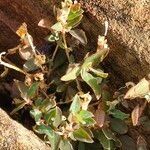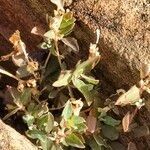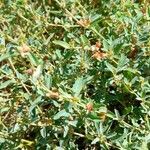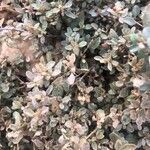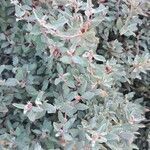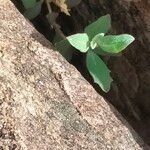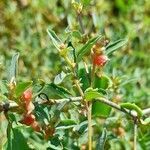Prostrate or decumbent perennial herb with slender spreading branches arising from a woody taproot, monoecious. Leaves thin, oblong-elliptic, obtuse, shortly petiolate, 1–2 cm long, almost glabrous above, scaly beneath, margin sinuate, dentate to entire. Male flowers in small glomerules in distal axils; female flowers in scattered axillary clusters. Fruiting bracteoles minutely pedicellate, rhomboid, 2–5 mm long and wide, acute, red and succulent (in southern variation) or thin, dry and deltoid, coarsely reticulate when dry, united in lower half, or only at base, glabrous; margin entire or with 1–4 small teeth; appendages absent or rarely 1 or 2 present. Seed with ascending radicle. [See also Green (1994).]
Annual, occasionally perennial, herb, up to 0.6 m high; dioecious. Stems procumbent or decumbent, with branches, long, loosely branched, matforming. Leaves herbaceous, weakly scaly, green, shortly petiolate; blade oblong-elliptic or narrowly ovate or obovate, margins irregularly sharply sinuately dentate or entire. Flowers: inflorescences terminal or in axils of leaves; fruiting bracts distinctly rhomboid in outline with deltoid apical lobes, without a distinctive base, yellowish, brown to black in fruit; Oct.-Mar. Fruit becoming semibaccate when ripe, turning red to orange.
A shrub that keeps growing from year to year. It grows 50 cm high and spreads 1 m wide. The stem lies along the ground and the branches are low and spreading. The leaves are sword shaped and silvery green. They are 2 cm long and have teeth around the edge. The flowers are very small. The fruit are flattened red berries.
Monoecious, sprawling perennial, 0.07-0.60 m, with mealy grey to white vesicular scales. Leaves elliptic-obovate, often coarsely toothed, glabrescent above. Flowers minute in axillary clusters. Flowering time mainly Sept.-Dec. Fruiting bracts rhomboid, red and fleshy, 2-5 mm long.
Monoecious, grey-mealy, sprawling perennial herb, up to 300 mm tall. Leaves elliptic-obovate, often coarsely toothed, glabrescent above. Flowers minute in axillary clusters. Fruiting bracteoles rhomboid, free to ± near base, red, fleshy. Mainly Sept.-Dec.
Monoecious, grey-mealy, sprawling perennial to 30 cm. Leaves elliptic-obovate, often coarsely toothed, glabrescent above. Flowers minute in axillary clusters; fruiting bracts rhomboid, red and fleshy, 2-5 mm long.
Prostrate herb. Fruit becoming semibaccate when ripe, turning red to orange. Fruiting bracts distinctly rhomboid in outline with deltoid apical lobes. Flowers yellow.
